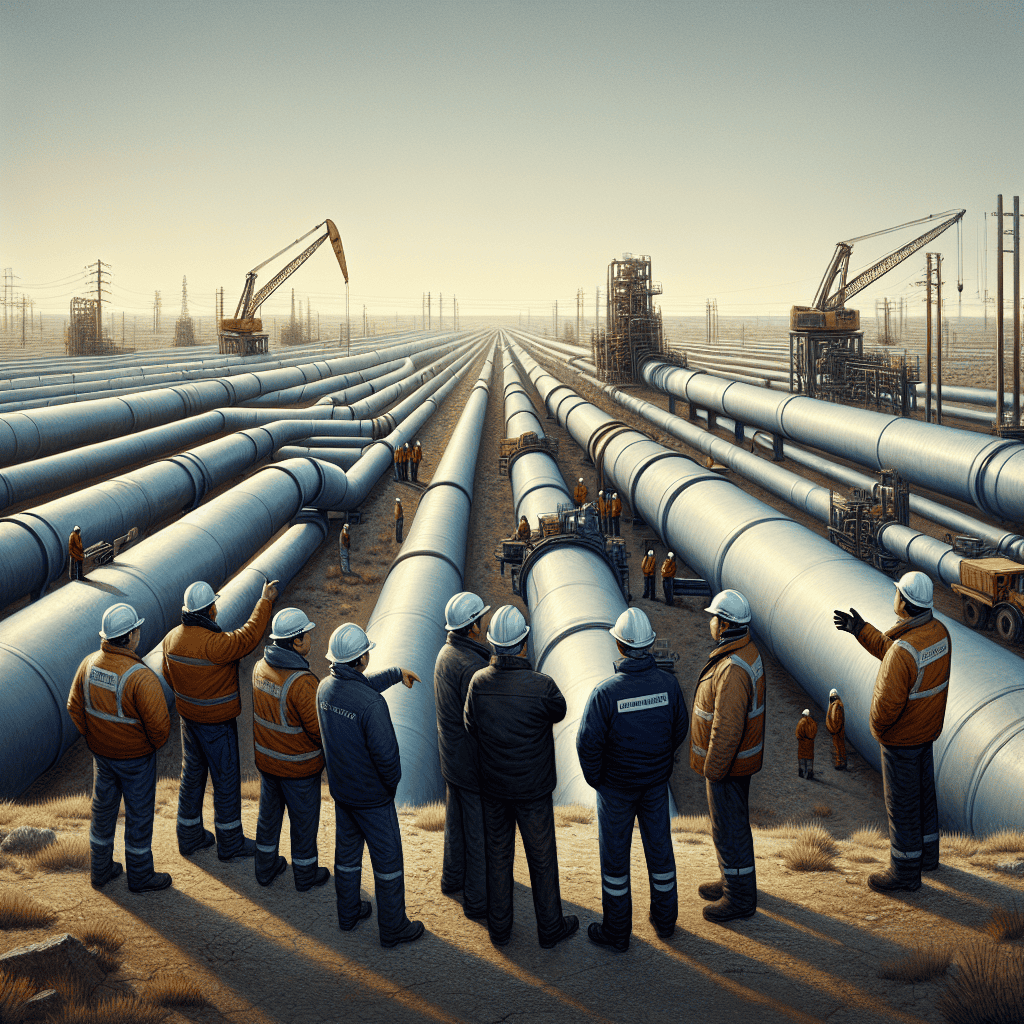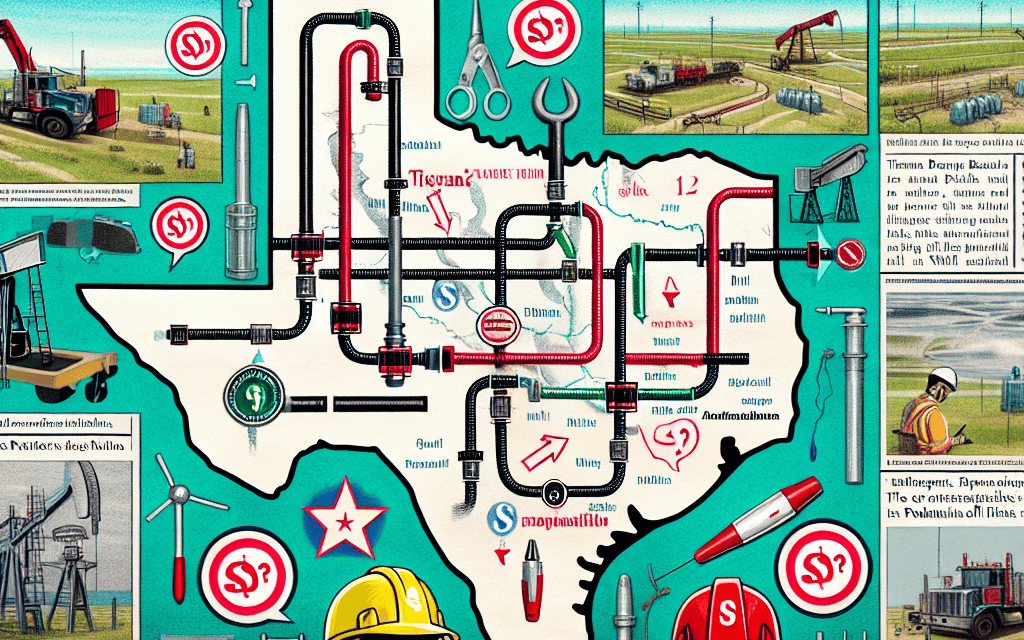“Forecasting a Future: No New Pipelines, Just New Possibilities in the Permian.”
Introduction
In recent industry developments, leading operators in the oil sector have projected that no new oil pipelines will be constructed in the Permian Basin, a significant shift in the energy landscape. This prediction comes amid evolving market dynamics, regulatory challenges, and a growing emphasis on sustainable energy practices. The Permian Basin, spanning West Texas and southeastern New Mexico, has been a cornerstone of U.S. oil production, driving substantial economic growth and energy independence. However, with existing pipeline infrastructure nearing capacity and a heightened focus on environmental concerns, industry leaders are reassessing future investments in pipeline projects. This anticipated halt in new pipeline construction reflects broader trends in the energy sector, where companies are increasingly prioritizing efficiency, technological innovation, and environmental stewardship over traditional expansion strategies. As the industry navigates these changes, the implications for regional economies, energy markets, and environmental policies are profound, signaling a pivotal moment in the transition towards a more sustainable energy future.
Impact Of No New Permian Oil Pipelines On U.S. Energy Independence
The recent consensus among top operators that no new oil pipelines will be constructed in the Permian Basin has significant implications for U.S. energy independence. As the Permian Basin is one of the most prolific oil-producing regions in the world, any changes in its infrastructure development can have far-reaching effects on the nation’s energy landscape. The decision to halt the construction of new pipelines stems from a combination of market dynamics, regulatory challenges, and evolving energy policies. This development necessitates a closer examination of how it might influence the United States’ quest for energy independence.
To begin with, the Permian Basin has been a cornerstone of U.S. oil production, contributing significantly to the country’s ability to reduce its reliance on foreign oil imports. The region’s vast reserves and advanced extraction technologies have enabled the U.S. to become a net exporter of oil in recent years. However, the absence of new pipeline infrastructure could potentially hinder the efficient transportation of oil from the Permian to key markets. Pipelines are the most cost-effective and environmentally friendly means of transporting large volumes of crude oil over long distances. Without new pipelines, producers may face bottlenecks, leading to increased transportation costs and reduced competitiveness in the global market.
Moreover, the decision not to build new pipelines may also impact the economic viability of future oil projects in the Permian Basin. Investors and operators might be deterred by the prospect of limited transportation options, which could lead to a slowdown in production growth. This, in turn, could affect the overall supply of domestic oil, making the U.S. more susceptible to fluctuations in global oil prices. As a result, the nation’s energy independence could be compromised, as it may need to rely more heavily on imports to meet its energy needs.
In addition to economic considerations, environmental and regulatory factors play a crucial role in the decision to halt new pipeline construction. Increasingly stringent environmental regulations and growing public opposition to fossil fuel infrastructure projects have made it more challenging to secure the necessary permits and approvals for new pipelines. This shift reflects a broader trend towards renewable energy sources and a commitment to reducing carbon emissions. While this transition is essential for addressing climate change, it also presents challenges for maintaining energy independence in the short to medium term.
Furthermore, the lack of new pipelines could accelerate the adoption of alternative transportation methods, such as rail and trucking. While these options provide flexibility, they are generally more expensive and less efficient than pipelines. Additionally, they pose higher safety risks and have a greater environmental impact due to increased emissions. Consequently, the reliance on these alternatives could undermine efforts to achieve energy independence by increasing the overall cost and environmental footprint of domestic oil production.
In conclusion, the prediction that no new Permian oil pipelines will be constructed carries significant implications for U.S. energy independence. While it aligns with broader environmental goals and reflects changing market dynamics, it also presents challenges in terms of transportation efficiency, production growth, and economic competitiveness. As the nation navigates this complex landscape, it will be crucial to balance the pursuit of energy independence with the need for sustainable and environmentally responsible energy solutions. This delicate balance will determine the future trajectory of the U.S. energy sector and its ability to maintain a secure and independent energy supply.
Economic Implications For Local Communities In The Permian Basin
The recent consensus among top operators that no new oil pipelines will be constructed in the Permian Basin has significant economic implications for local communities. This decision, driven by a combination of market dynamics and environmental considerations, marks a pivotal shift in the region’s economic landscape. Historically, the Permian Basin has been a powerhouse of oil production, contributing substantially to both local and national economies. The construction of pipelines has not only facilitated the efficient transport of oil but has also been a source of employment and economic activity. However, the current outlook suggests a departure from this trend, prompting a reevaluation of economic strategies for communities that have long relied on the oil industry.
To begin with, the absence of new pipeline projects may lead to a stagnation in job creation within the region. Pipeline construction has traditionally provided numerous employment opportunities, ranging from skilled labor to engineering and project management roles. Without new projects on the horizon, the demand for such jobs is likely to diminish, potentially leading to higher unemployment rates. This could have a ripple effect on local economies, as reduced employment in the oil sector may decrease consumer spending, affecting businesses that rely on the patronage of oil industry workers.
Moreover, the decision not to construct new pipelines could impact local government revenues. Pipelines contribute significantly to the tax base, providing funds that are essential for public services such as education, infrastructure, and healthcare. A decline in pipeline-related activities may result in reduced tax revenues, compelling local governments to explore alternative sources of funding or to make difficult budgetary decisions. This could lead to cuts in public services, affecting the quality of life for residents in the Permian Basin.
In addition to these direct economic impacts, the shift away from new pipeline construction may also influence the broader economic development strategies of local communities. With the oil industry no longer serving as a guaranteed engine of growth, there may be an increased impetus to diversify local economies. This could involve investing in renewable energy projects, promoting tourism, or supporting small businesses and startups. While diversification presents opportunities for sustainable economic growth, it also requires careful planning and investment, as well as a willingness to embrace new industries and technologies.
Furthermore, the environmental considerations that have contributed to the decision not to build new pipelines may also play a role in shaping the future economic landscape of the Permian Basin. As the global community increasingly prioritizes sustainability and the reduction of carbon emissions, there may be opportunities for the region to position itself as a leader in green energy. This could involve leveraging existing expertise in energy production to develop and implement innovative solutions that align with environmental goals.
In conclusion, the prediction that no new oil pipelines will be constructed in the Permian Basin carries significant economic implications for local communities. While the immediate effects may include reduced employment opportunities and decreased tax revenues, there is also potential for positive change through economic diversification and a focus on sustainability. As these communities navigate this transition, strategic planning and investment will be crucial to ensuring a resilient and prosperous future. The challenge lies in balancing the immediate economic needs with long-term goals, fostering an environment where new industries can thrive alongside traditional ones.
Environmental Benefits Of Halting New Pipeline Construction
The decision by top operators to halt the construction of new oil pipelines in the Permian Basin marks a significant shift in the energy sector, with profound implications for environmental sustainability. This move, driven by a combination of market dynamics and environmental considerations, offers a unique opportunity to explore the potential environmental benefits associated with such a decision. As the world grapples with the pressing need to address climate change, the cessation of new pipeline projects in one of the most prolific oil-producing regions in the United States could serve as a pivotal step towards reducing the carbon footprint of fossil fuel extraction and transportation.
To begin with, the environmental benefits of halting new pipeline construction are manifold. One of the most immediate advantages is the reduction in greenhouse gas emissions. Pipelines, while efficient in transporting oil, are also significant sources of methane leaks, a potent greenhouse gas. By not constructing new pipelines, the industry can avoid the additional emissions that would result from both the construction process and potential leaks during operation. This aligns with global efforts to mitigate climate change by reducing emissions from all sectors, including energy.
Moreover, the decision to forego new pipeline projects can lead to a decrease in habitat disruption. Pipeline construction often requires extensive land clearing, which can have detrimental effects on local ecosystems. The Permian Basin, home to diverse flora and fauna, would benefit from reduced habitat fragmentation, allowing for the preservation of biodiversity. This is particularly important in regions where endangered species may be present, as it minimizes the risk of further endangerment or extinction.
In addition to these direct environmental benefits, the halt in new pipeline construction can also encourage the adoption of alternative energy sources. As the industry shifts focus away from expanding oil infrastructure, there is a greater impetus to invest in renewable energy technologies. This transition not only supports the global agenda for sustainable energy but also fosters innovation and economic diversification within the energy sector. By prioritizing renewables, the industry can contribute to a more sustainable energy future, reducing reliance on fossil fuels and promoting cleaner energy solutions.
Furthermore, the decision to stop building new pipelines can enhance community relations and reduce social conflicts. Pipeline projects often face opposition from local communities and environmental groups concerned about potential spills and environmental degradation. By not pursuing new projects, operators can alleviate these tensions, fostering better relationships with stakeholders and demonstrating a commitment to environmental stewardship. This can lead to increased public trust and support for the industry’s broader initiatives.
While the decision to halt new pipeline construction in the Permian Basin is primarily driven by market conditions, the environmental benefits cannot be overlooked. The reduction in greenhouse gas emissions, preservation of habitats, encouragement of renewable energy adoption, and improved community relations collectively contribute to a more sustainable and environmentally conscious approach to energy production. As the world continues to seek solutions to the climate crisis, such decisions by major industry players underscore the importance of aligning economic activities with environmental priorities. In conclusion, the cessation of new pipeline projects in the Permian Basin represents a critical step towards achieving a balance between energy needs and environmental preservation, setting a precedent for future actions in the energy sector.
How The Oil Market Will Adapt To Pipeline Constraints

In recent years, the Permian Basin has emerged as a cornerstone of the United States’ oil production, contributing significantly to the nation’s energy output. However, as top operators predict that no new oil pipelines will be constructed in the region, the industry faces a pivotal challenge: how to adapt to these pipeline constraints while maintaining efficiency and profitability. This situation necessitates a strategic reevaluation of current practices and the exploration of innovative solutions to ensure the continued flow of oil from this prolific area.
To begin with, the absence of new pipeline infrastructure in the Permian Basin compels operators to optimize the use of existing pipelines. This involves enhancing the efficiency of current systems through technological upgrades and improved maintenance practices. By investing in advanced monitoring and control technologies, operators can maximize throughput and minimize downtime, thereby ensuring that existing pipelines operate at their full potential. Moreover, the implementation of predictive maintenance strategies can help preemptively address potential issues, reducing the risk of disruptions and extending the lifespan of these critical assets.
In addition to optimizing existing infrastructure, the industry is likely to see an increased reliance on alternative transportation methods. Rail and trucking, for instance, offer flexible solutions for transporting oil when pipeline capacity is insufficient. While these methods may not match the cost-effectiveness of pipelines, they provide essential stopgap measures that can alleviate bottlenecks and ensure that oil continues to reach refineries and markets. Furthermore, advancements in logistics and supply chain management can enhance the efficiency of these alternative transportation modes, making them more viable options in the face of pipeline constraints.
Another significant adaptation strategy involves the strategic location of new production facilities and refineries closer to existing pipeline networks. By situating these facilities in proximity to established infrastructure, operators can reduce the distance that oil must travel, thereby minimizing transportation costs and logistical complexities. This approach not only mitigates the impact of pipeline limitations but also supports regional economic development by creating jobs and stimulating local economies.
Moreover, the industry is likely to witness a shift towards more sustainable practices as a response to pipeline constraints. The integration of renewable energy sources and the adoption of carbon capture and storage technologies can help reduce the environmental impact of oil production and transportation. By investing in these green technologies, operators can align with global sustainability goals while also enhancing their operational resilience in a constrained pipeline environment.
Finally, collaboration among industry stakeholders will be crucial in navigating the challenges posed by pipeline limitations. By fostering partnerships and sharing resources, operators can develop coordinated strategies that optimize the use of existing infrastructure and explore innovative solutions. This collaborative approach can also facilitate the exchange of best practices and technological advancements, driving the industry towards more efficient and sustainable operations.
In conclusion, while the prediction of no new oil pipelines in the Permian Basin presents a significant challenge, it also offers an opportunity for the industry to innovate and adapt. Through the optimization of existing infrastructure, the exploration of alternative transportation methods, strategic facility placement, the adoption of sustainable practices, and enhanced collaboration, the oil market can effectively navigate these constraints. As the industry evolves, these strategies will be instrumental in ensuring the continued success and resilience of oil production in the Permian Basin.
The Role Of Renewable Energy In The Permian Basin’s Future
In recent years, the Permian Basin has been a focal point of the United States’ oil production, contributing significantly to the nation’s energy output. However, a shift in the energy landscape is prompting top operators to predict that no new oil pipelines will be constructed in the region. This change is largely driven by the increasing role of renewable energy sources, which are gradually reshaping the future of the Permian Basin. As the world moves towards more sustainable energy solutions, the emphasis on renewable energy is becoming more pronounced, influencing both market dynamics and infrastructure development.
The transition to renewable energy is not merely a trend but a necessary evolution in response to global environmental concerns and the pressing need to reduce carbon emissions. In the Permian Basin, this shift is evident as companies and policymakers alike are recognizing the potential of renewable energy to complement and eventually transform the region’s energy profile. Solar and wind energy, in particular, are gaining traction due to the Basin’s favorable geographic conditions, which offer abundant sunlight and wind resources. Consequently, investments in renewable energy infrastructure are on the rise, signaling a strategic pivot from traditional fossil fuel reliance.
Moreover, the economic viability of renewable energy is becoming increasingly attractive. Technological advancements have significantly reduced the cost of solar panels and wind turbines, making them competitive alternatives to oil and gas. This economic shift is further supported by government incentives and policies aimed at promoting clean energy adoption. As a result, energy companies operating in the Permian Basin are diversifying their portfolios to include renewable energy projects, thereby reducing their dependency on oil and gas pipelines.
In addition to economic factors, societal and environmental considerations are playing a crucial role in shaping the future of energy in the Permian Basin. Public awareness and concern about climate change have led to increased pressure on companies to adopt more sustainable practices. This societal shift is influencing corporate strategies, with many companies setting ambitious targets for reducing their carbon footprint. By investing in renewable energy, these companies are not only aligning with global sustainability goals but also enhancing their reputation and competitiveness in an evolving market.
Furthermore, the anticipated decline in new oil pipeline construction is also a reflection of changing energy consumption patterns. As renewable energy becomes more integrated into the grid, the demand for oil is expected to plateau or even decrease over time. This shift in demand dynamics reduces the necessity for additional pipeline infrastructure, as existing networks may suffice to meet future needs. Consequently, energy companies are focusing on optimizing current assets and exploring innovative solutions to integrate renewable energy into their operations.
In conclusion, the prediction that no new oil pipelines will be constructed in the Permian Basin underscores the transformative impact of renewable energy on the region’s future. As the world continues to prioritize sustainability, the role of renewable energy in the Permian Basin is set to expand, driving economic, environmental, and societal benefits. This transition not only reflects a broader global movement towards clean energy but also highlights the adaptability and forward-thinking strategies of energy companies operating in the region. As the Permian Basin navigates this energy evolution, it stands as a testament to the potential of renewable energy to redefine traditional energy landscapes.
Challenges Facing Oil Transportation Without New Pipelines
The Permian Basin, a vast expanse of oil-rich land stretching across West Texas and southeastern New Mexico, has long been a cornerstone of the United States’ oil production. As one of the most prolific oil-producing regions in the world, the Permian has consistently driven the nation’s energy output to new heights. However, recent predictions by top operators suggest that no new oil pipelines will be constructed in the region, a development that poses significant challenges for oil transportation.
The absence of new pipeline infrastructure in the Permian Basin is primarily attributed to a combination of economic, regulatory, and environmental factors. Economically, the fluctuating price of oil has made it difficult for companies to justify the substantial investment required to build new pipelines. The volatility in oil prices, driven by global market dynamics and geopolitical tensions, has led to a cautious approach among operators who are wary of committing to long-term projects that may not yield the expected returns.
Moreover, regulatory hurdles have become increasingly formidable. The process of obtaining the necessary permits and approvals for pipeline construction has grown more complex and time-consuming. This is partly due to heightened scrutiny from government agencies and public opposition, which often centers on environmental concerns. The potential impact of pipelines on local ecosystems, water sources, and communities has fueled resistance, leading to prolonged legal battles and delays.
In addition to these challenges, the growing emphasis on environmental sustainability and the transition to renewable energy sources have further complicated the landscape for new pipeline projects. As governments and corporations alike strive to reduce carbon emissions and combat climate change, there is a palpable shift away from fossil fuel infrastructure. This shift is reflected in policy decisions and investment strategies that prioritize cleaner energy alternatives over traditional oil and gas projects.
Without the construction of new pipelines, the Permian Basin faces significant logistical challenges in transporting its oil to market. Existing pipelines are already operating at or near capacity, and the lack of additional infrastructure could lead to bottlenecks. These bottlenecks not only hinder the efficient movement of oil but also result in increased transportation costs. As operators are forced to rely on alternative methods such as rail and truck transport, the cost per barrel rises, impacting profitability and potentially leading to higher prices for consumers.
Furthermore, the reliance on rail and truck transport introduces additional risks and inefficiencies. Rail transport, while capable of moving large volumes of oil, is subject to delays and accidents, which can have severe environmental and safety implications. Truck transport, on the other hand, is less efficient for long distances and contributes to increased road traffic and emissions.
In light of these challenges, operators in the Permian Basin are exploring innovative solutions to optimize existing infrastructure and enhance oil transportation efficiency. Technological advancements in pipeline monitoring and maintenance, as well as strategic partnerships and collaborations, are being pursued to mitigate the impact of limited pipeline capacity. Additionally, some companies are investing in infrastructure upgrades and expansions to existing pipelines, which can provide incremental capacity increases without the need for entirely new projects.
In conclusion, the prediction that no new oil pipelines will be constructed in the Permian Basin presents a complex set of challenges for oil transportation. Economic, regulatory, and environmental factors have converged to create a landscape where traditional pipeline projects are increasingly difficult to justify. As operators navigate this evolving environment, innovative solutions and strategic adaptations will be crucial in ensuring the continued flow of oil from this vital region to markets across the globe.
The Influence Of Regulatory Policies On Pipeline Development Decisions
In recent years, the landscape of oil pipeline development in the Permian Basin has been significantly influenced by a complex interplay of market dynamics and regulatory policies. Top operators in the region now predict that no new oil pipelines will be constructed in the foreseeable future. This prediction is not merely a reflection of current market conditions but also a testament to the profound impact of regulatory frameworks on the decision-making processes of energy companies.
To begin with, the Permian Basin, which spans parts of Texas and New Mexico, has long been a cornerstone of the United States’ oil production. Its prolific output has necessitated a robust infrastructure to transport crude oil to refineries and export terminals. However, the recent surge in regulatory scrutiny has introduced new challenges for pipeline development. Environmental regulations, in particular, have become more stringent, requiring companies to adhere to rigorous standards that often extend project timelines and inflate costs. These regulations are designed to mitigate the environmental impact of pipeline construction and operation, but they also add layers of complexity to the approval process.
Moreover, the regulatory landscape is not static; it evolves in response to political shifts and public sentiment. In recent years, there has been a growing emphasis on transitioning to renewable energy sources, which has influenced policy decisions at both federal and state levels. This shift in focus has led to increased regulatory hurdles for fossil fuel infrastructure projects, including oil pipelines. Consequently, energy companies are finding it increasingly challenging to justify the financial and operational risks associated with new pipeline construction.
In addition to environmental regulations, social and community considerations have gained prominence in the regulatory discourse. Public opposition to pipeline projects, often fueled by concerns over land rights and potential environmental hazards, has prompted regulators to adopt more inclusive and transparent decision-making processes. This has resulted in longer consultation periods and more comprehensive impact assessments, further complicating the pipeline approval process. As a result, companies are now more cautious in their approach, weighing the potential for community pushback against the economic benefits of new infrastructure.
Furthermore, the economic viability of new pipelines is being reassessed in light of changing market conditions. The global oil market has experienced significant volatility, with fluctuating prices and shifting demand patterns. This uncertainty has prompted operators to adopt a more conservative stance, prioritizing the optimization of existing infrastructure over the development of new projects. The focus has shifted towards enhancing the efficiency and capacity of current pipelines, which is often seen as a more cost-effective and less risky strategy.
In conclusion, the prediction by top operators that no new Permian oil pipelines will be constructed is a reflection of the intricate balance between regulatory policies and market realities. The evolving regulatory environment, characterized by stringent environmental standards and heightened community engagement, has introduced new challenges for pipeline development. Coupled with economic uncertainties, these factors have led energy companies to adopt a more cautious approach, prioritizing the optimization of existing infrastructure over new construction. As the energy landscape continues to evolve, the influence of regulatory policies on pipeline development decisions will remain a critical factor shaping the future of the Permian Basin and the broader oil industry.
Q&A
1. **Why are top operators predicting no new Permian oil pipelines will be constructed?**
Top operators predict no new pipelines due to existing infrastructure meeting current and near-future demand, alongside market uncertainties and environmental concerns.
2. **What factors are influencing the decision against constructing new pipelines?**
Factors include sufficient current pipeline capacity, fluctuating oil prices, regulatory challenges, and increased focus on renewable energy sources.
3. **How does the current pipeline capacity in the Permian Basin affect this prediction?**
The current pipeline capacity is adequate to handle existing production levels, reducing the immediate need for additional infrastructure.
4. **What role do environmental concerns play in the decision-making process?**
Environmental concerns, including regulatory pressures and public opposition to fossil fuel projects, discourage new pipeline construction.
5. **Are there any economic implications of not building new pipelines in the Permian Basin?**
Economic implications may include limited growth in oil production and potential impacts on local economies reliant on oil industry expansion.
6. **How might this prediction impact future oil production in the Permian Basin?**
Future oil production may stabilize or grow at a slower rate due to transportation constraints, potentially leading to increased efficiency in existing operations.
7. **What alternatives to new pipeline construction are being considered by operators?**
Alternatives include optimizing existing pipeline usage, investing in rail and truck transportation, and enhancing storage facilities.
Conclusion
The conclusion regarding top operators predicting no new Permian oil pipelines will be constructed is that the current infrastructure is deemed sufficient to handle existing and anticipated production levels. This suggests a stabilization in production growth or a shift in focus towards optimizing existing assets and enhancing operational efficiencies. Additionally, it may reflect broader industry trends such as increased regulatory scrutiny, environmental concerns, and a strategic pivot towards renewable energy sources. The decision not to build new pipelines could also indicate confidence in the capacity of current pipelines to meet market demands, or a response to economic factors such as fluctuating oil prices and investment risks.





